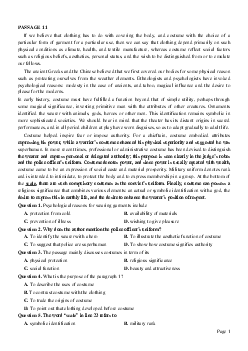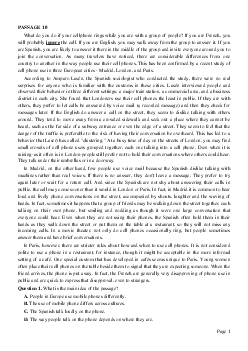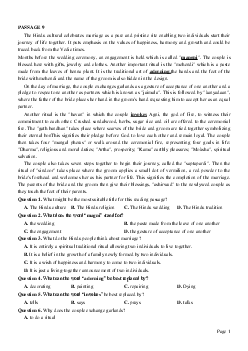


Preview text:
PASSAGE 14
Recent technological advances in manned and unmanned vehicles, along with breakthroughs in satellite
technology and computer equipment, have overcome some of the limitations of divers and diving
equipment for scientists doing research on the great oceans of the world. Without a vehicle, divers often
became sluggish, and their mental concentration was severely limited. Because undersea pressure affects
their speech organs, communication among divers has always been difficult or impossible.
But today, most oceanographers avoid the use of vulnerable human divers, preferring to reduce the risk to
human life and make direct observations by means of instruments that are lowered into the ocean, from
samples take from the water, or from photographs made by orbiting satellites. Direct observations of the
ocean floor can be made not only by divers but also by deep-diving submarines in the water and even by
the technology of sophisticated aerial photography from vantage points above the surface of more than
seven miles and cruise at depths of fifteen thousand feet. In addition, radio-equipped buoys can be
operated by remote control in order to transmit data back to land-based laboratories via satellite.
Particularly important for ocean study are data about water temperature, currents, and weather. Satellite
photographs can show the distribution of sea ice, oil slicks, and cloud formations over the ocean. Maps
created from satellite pictures can represent the temperature and the color of the ocean’s surface, enabling
researchers to study the ocean currents from laboratories on dry land. Furthermore, computers help
oceanographers to collect, organize, and analyze information from submarines and satellites. By creating
a model of the ocean’s movement and characteristics, scientists can predict the patterns and possible
effects of the ocean on the environment.
Recently, many oceanographers have been relying more on satellites and computers than on research
ships or even submarine vehicles because they can supply a greater range of information more quickly
and more effectively. Some of humankind’s most serious problems, especially those concerning energy
and food, may be solved with the help of observations made possible by this new technology.
Question 1. With what topic is the passage primarily concerned?
A. Communication among drivers.
B. Direct observation of the ocean floor. C. Undersea vehicles.
D. Technological advances in oceanography.
Question 2. The word “sluggish” is closest in meaning to . A. very weak B. nervous C. confused D. slow moving
Question 3. This passage suggests that the successful exploration of the ocean depends upon .
A. vehicles as well as divers
B. controlling currents and the weather
C. radios that divers use to communicate
D. the limitations of diving equipment
Question 4. Divers have had problems in communicating underwater because .
A. they did not pronounce clearly
B. the water destroyed their speech organs
C. the pressure affected their speech organs
D. the vehicles they used have not been perfected
Question 5. The word “cruise” could best be replaced by .
A. travel at a constant speed
B. function without problems
C. stay in communication D. remain still
Question 6. Undersea vehicles .
A. are too small for a man to fit inside
B. have the same limitations that divers have
C. are very slow to respond
D. make direct observations of the ocean floor Page 1
Question 7. The word “data” is closest in meaning to . A. samples B. photographs C. information D. articles
Question 8. How is a radio-quipped buoy operated?
A. by operators outside the vehicle on a diving platform.
B. by operators outside the vehicle in a laboratory on shore.
C. By operators outside the vehicle on ship.
D. by operators inside the vehicle in the part underwater.
Question 9. Which of the following are NOT shown in satellite photographs?
A. The location of sea ice.
B. Cloud formations over the ocean.
C. The temperature of the ocean’s surface.
D. A model of the ocean’s movements.
Question 10. The words “those” refers to . A. vehicles B. problems C. ships D. computers ĐÁP ÁN 1-D 2-D 3-A 4-C 5-A 6-D 7-C 8-B 9-D 10-B Question 1:
Câu chủ đề nằm ở ngay đầu bài khóa:
“Recent technological advances in manned and unmanned vehicles, along with breakthroughs in satellite
technology and computer equipment, have overcome some of the limitations of divers and diving
equipment for scientists doing research on the great oceans of the world” => những tiến bộ về khoa học
trong ngành đại dương học Question 2:
Sluggish: chậm chạp, uể oải = slow moving Nervous: lo lắng Very weak: rất yếu
Confused: bối rối, lúng túng Question 3:
A (hint trong bài là: Direct observations of the ocean floor can be made not only by divers but also by deep-diving submarines) Question 4:
C (có thể dễ dàng tìm thấy câu chứa thông tin trong bài: Because undersea pressure affects their speech organs,) Question 5:
Cruise: cuộc du ngoạn = đi với 1 tốc độ đều, ổn định Question 6:
C (câu chứa thông tin trong bài: Direct observations of the ocean floor can be made not only by divers but
also by deep-diving submarines ( đây chính là thay cho “undersea vehicles”) in the water) Page 2 Question 7:
Data = information: dữ liệu, thông tin Question 8:
“radio-equipped buoys can be operated by remote control in order to transmit data back to land-based
laboratories via satellite” => những chiếc phao cứu hộ được điều khiển từ xa qua phòng thí nghiệm qua hệ thống vệ tinh. Question 9:
“Satellite photographs can show the distribution of sea ice, oil slicks, and cloud formations over the ocean.” ----> A, B. C đều có
-----> D là không được nhắc đến Question 10:
“Some of humankind’s most serious problems, especially those concerning energy and food” => Một số
vấn đề nghiêm trọng liên quan đến con người , đặc biệt và những vấn đề liên quan đến năng lượng và thức ăn, Page 3




